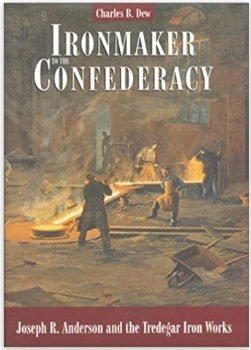
Four books offer an introduction to Virginia’s industrialization throughout the 1800s. The first as an introduction is “Tredegar Iron Works” by Nathan Vernon Madison in a short popular history spanning the antebellum period into the 1920s. Richmond’s first railroad was built to transport Midlothian coal and the second volume on Virginia industry is “Old Dominion, Industrial Commonwealth” by Sean Patrick Adams, a more extensive comparison of the political policy in the coal industry of Virginia and Pennsylvania, accounting for their exchanging places in American industrial prominence by the end of the 1830s.
The Valley of Virginia experienced migration from Pennsylvania for decades, and one entrepreneur was William Weaver who established an iron forge at Buffalo Forge nearby Lexington using industrial slave labor, as described in “Bond of Iron” by Charles B. Dew. The last book of this introductory series is “Ironmaker to the Confederacy”, also by Charles B. Dew, a classic first published in 1966 and reprinted in 1999, briefly describing the Tredegar Iron Works use of slave industrial labor in the Antebellum era, then concentrating on its Civil War production, with a last chapter on “Back to Business” during Reconstruction.
Tredegar Iron Works

Tredegar Iron Works: Richmond’s Foundry on the James (2015) by Nathan Vernon Madison is a 192 paged popular history of the Richmond iron works that produced military cannon and equipment during five wars and contributed to the growing railroads of the Gilded Age and supplied items for the railroad, horseshoe and ordnance industries into the 1920s. More than a small-time parochial business, it maintained the characteristics of an antebellum enterprise, without steel innovations and without the giant growth of Andrew Carnegie’s U.S. Steel. Buy “Tredegar Iron Works” at Amazon.com here.
Old Dominion, Industrial Commonwealth

Old Dominion, Industrial Commonwealth: coal politics and economy in Antebellum America (2010) by Sean Patrick Adams in 300 pages shows that state legislature politics built institutional structures for the coal industry in both Virginia and Pennsylvania. In Virginia the landed elites fostered policy that proved incapable of balancing disparate geographic and industrial interests. With limited canals improvements, restricted incorporation laws and prohibitive restraint on capital formation, Virginia fell behind Pennsylvania in coal production between 1820 and the end of the 1830s.
The Pennsylvanians started behind the Virginians in the 1790s, their anthracite coal was harder to mine and more difficult to ignite for commercial and domestic use than Virginia’s bituminous coal. But the Pennsylvania canal system connected its fields to eastern markets, and the addition of British coal miners brought skills and innovation that increased productivity not seen among Virginia’s enterprises of slave labor. The Virginian political strategy which served only its eastern tobacco interests led inevitably to an eclipse of Virginia’s leadership in coal production. Buy “Old Dominion, Industrial Commonwealth” at Amazon.com here.
Bond of Iron

Bond of Iron: Master and Slave at Buffalo Forge (1994) by Charles B. Dew is a contribution to Virginia history and industrial slavery in a location nearby Lexington, Virginia. In 448 pages, Dew describes Pennsylvania immigrant entrepreneur William Weaver as a well capitalized slaveowner, training field hands as master refiners such as Sam Williams and Garland Thompson, slave forgeman. Weaver was then able to supplement them occasionally with semi-skilled and unskilled hired slaves.
Dew portrays the production of an industrial community among the slaves, their familial roles, and how the slaves built their own work-a-day and cultural world, autonomously employing their cash wages and savings. Weaver’s laborers transitioned between plantation slavery and slavery in mixed economies, although disruptive or unproductive slaves were sold away rather than harshly discilplined. This study extends beyond the Civil War, describing the dynamics of the Valley of Virginia workplace under agricultural, industrial and post-emancipation conditions. Buy “Bond of Iron” at Amazon.com here.
Ironmaker to the Confederacy

Ironmaker to the Confederacy: Joseph R. Anderson and the Tredegar Iron Works (1966, 1999) by Charles B. Dew is a 345 paged account primarily of the Iron Works as economic and management history, although Anderson’s support of secession as a means to concentrate his markets and increase profits, and later his wartime use of blockade running to build up reserves in British banks to continue operation after the fall of the Confederacy are also treated.
Perhaps outside of the flour mills surrounding Richmond, Tredegar was the major industrial presence in Virginia and in the South, employing over a thousand hired slaves and free laborers. In some ways this is a companion volume to Kathleen Bruce, “Virginia Iron Manufacture in the Slave Era” (1930), now out of print, which traced the industry from colonial times and ended with Civil War chapters.
The antebellum development of bridge and railroad equipment for Southern market is outlined, Tredegar’s role in the Confederate war effort is developed, and a brief consideration of the post-war marketing for railroad construction is detailed.
Slave labor, which gave a competitive cost advantage over northern producers could not overcome shortages in raw materials, transport difficulties and a dwindling labor pool during wartime. Buy “Ironmaker to the Confederacy” at Amazon.com here.
Additional books are suggested for Virginia political and economic history here, and other fields of interest are found at the Book Club here. Use The Virginia Historian’s 12 Steps to build your Virginia library here.

